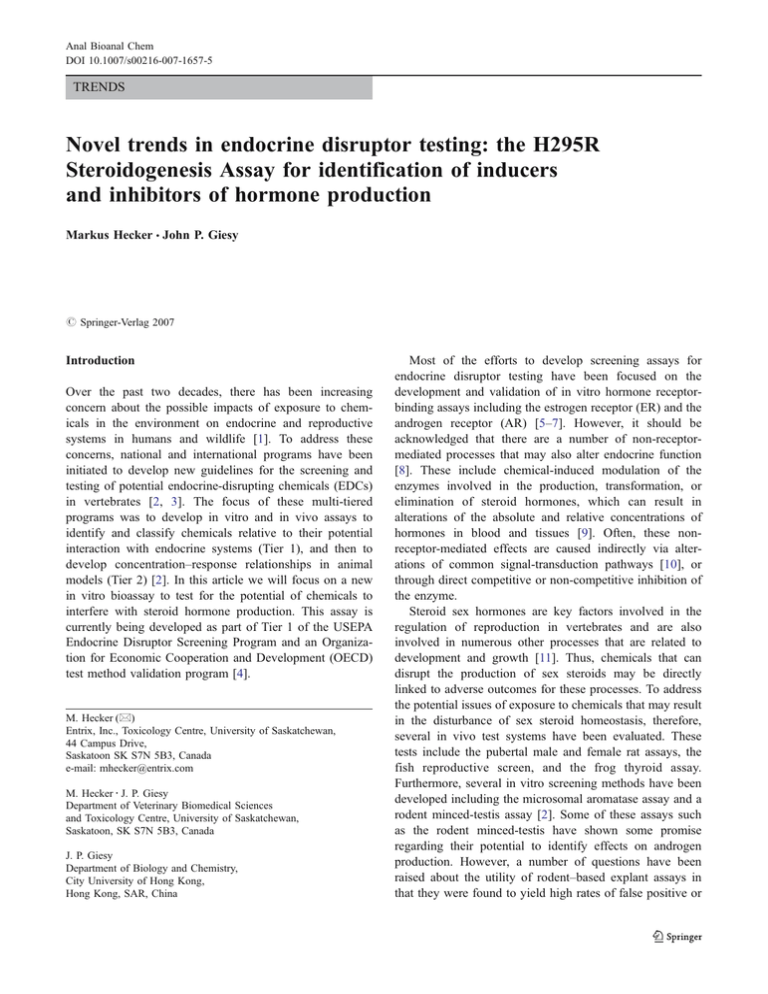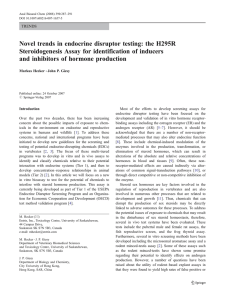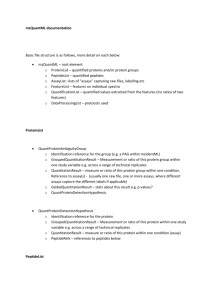Novel trends in endocrine disruptor testing: the H295R
advertisement

Anal Bioanal Chem DOI 10.1007/s00216-007-1657-5 TRENDS Novel trends in endocrine disruptor testing: the H295R Steroidogenesis Assay for identification of inducers and inhibitors of hormone production Markus Hecker & John P. Giesy # Springer-Verlag 2007 Introduction Over the past two decades, there has been increasing concern about the possible impacts of exposure to chemicals in the environment on endocrine and reproductive systems in humans and wildlife [1]. To address these concerns, national and international programs have been initiated to develop new guidelines for the screening and testing of potential endocrine-disrupting chemicals (EDCs) in vertebrates [2, 3]. The focus of these multi-tiered programs was to develop in vitro and in vivo assays to identify and classify chemicals relative to their potential interaction with endocrine systems (Tier 1), and then to develop concentration–response relationships in animal models (Tier 2) [2]. In this article we will focus on a new in vitro bioassay to test for the potential of chemicals to interfere with steroid hormone production. This assay is currently being developed as part of Tier 1 of the USEPA Endocrine Disruptor Screening Program and an Organization for Economic Cooperation and Development (OECD) test method validation program [4]. M. Hecker (*) Entrix, Inc., Toxicology Centre, University of Saskatchewan, 44 Campus Drive, Saskatoon SK S7N 5B3, Canada e-mail: mhecker@entrix.com M. Hecker : J. P. Giesy Department of Veterinary Biomedical Sciences and Toxicology Centre, University of Saskatchewan, Saskatoon, SK S7N 5B3, Canada J. P. Giesy Department of Biology and Chemistry, City University of Hong Kong, Hong Kong, SAR, China Most of the efforts to develop screening assays for endocrine disruptor testing have been focused on the development and validation of in vitro hormone receptorbinding assays including the estrogen receptor (ER) and the androgen receptor (AR) [5–7]. However, it should be acknowledged that there are a number of non-receptormediated processes that may also alter endocrine function [8]. These include chemical-induced modulation of the enzymes involved in the production, transformation, or elimination of steroid hormones, which can result in alterations of the absolute and relative concentrations of hormones in blood and tissues [9]. Often, these nonreceptor-mediated effects are caused indirectly via alterations of common signal-transduction pathways [10], or through direct competitive or non-competitive inhibition of the enzyme. Steroid sex hormones are key factors involved in the regulation of reproduction in vertebrates and are also involved in numerous other processes that are related to development and growth [11]. Thus, chemicals that can disrupt the production of sex steroids may be directly linked to adverse outcomes for these processes. To address the potential issues of exposure to chemicals that may result in the disturbance of sex steroid homeostasis, therefore, several in vivo test systems have been evaluated. These tests include the pubertal male and female rat assays, the fish reproductive screen, and the frog thyroid assay. Furthermore, several in vitro screening methods have been developed including the microsomal aromatase assay and a rodent minced-testis assay [2]. Some of these assays such as the rodent minced-testis have shown some promise regarding their potential to identify effects on androgen production. However, a number of questions have been raised about the utility of rodent–based explant assays in that they were found to yield high rates of false positive or Anal Bioanal Chem negative responses [12]. Also, in testis explant assays it is not possible to discriminate between cytotoxicity of hormone-producing cells and other cell types. Finally, there has been increasing criticism regarding the use of animals in screening type assays. As a result, there has been a need for less variable and more reliable in vitro test systems as alternatives to tissue explant assays that allow testing for the effects of chemicals on hormone production. The H295R Steroidogenesis Assay One cell line that has been shown to be a useful in vitro model for steroidogenic pathways and processes is the human H295R adrenocarcinoma cell line [8, 13]. The H295R cell line expresses genes that encode for all the key enzymes for steroidogenesis [10, 14] (Fig. 1). This is a unique property, because in vivo expression of these genes is tissue and developmental stage-specific with no one tissue or developmental stage expressing all of the genes involved in steroidogenesis. H295R cells have physiological characteristics of zonally undifferentiated human fetal adrenal cells [14]. The cells represent a unique in vitro system in that they have the ability to produce the steroid hormones found in the adult adrenal cortex and the gonads, allowing testing for effects on both corticosteroid synthesis and the production of sex steroid hormones such as androgens and estrogens. There are several additional advantages to the use of the H295R cell line. Its advantage over tissue-based assays is that it enables assessment of the potential impact of a chemical on cell viability and/or cytotoxicity. This is an important feature as it enables discrimination between effects due to cytotoxicity or to direct interaction with steroidogenic pathways, which is not possible in tissue explants that consist of multiple cell types. In addition, the NCI-H295R cells are commercially available from the American Type Culture Collections (ATCC CRL-2128; ATCC, Manassas, VA, USA). Thus, Fig. 1 Steroidogenic pathway in H295R cells. Enzymes are in italics, hormones are in bold, and arrows indicate the direction of synthesis. Gray background indicates corticosteroid pathways/products. Sex steroid pathways/products are circled. CYP = cytochrome P450; HSD = hydroxysteroid dehydrogenase these cells are available to everybody and no costly permissions are required as is the case for many other cell systems such as the CALUX assay. Based on the promising results obtained during initial studies researching the potential of the H295R cells to detect effects of chemicals on steroidogenesis including the production of testosterone, estradiol, or progestins [8], a standardized H295R Steroidogenesis Assay protocol was developed. The protocol is currently being tested in conjunction with the OECD in an international laboratory setting under the participation of seven independent laboratories [4]. In brief, the assay is performed under standard cell-culture conditions in 24-well culture plates (Fig. 2). After an acclimation period of 24 h, cells are exposed for 48 h to multiple concentrations of the test chemical in triplicate. In parallel, a plate with known inhibitors and inducers of hormone production is run as a quality control (QC). At the end of the exposure period, the medium is removed from each well and hormones are extracted using diethyl ether. Cell viability in each well is analyzed immediately after removal of the medium. Concentrations of hormones in the medium can be measured using commercially available hormone-detection kits, again making the assay accessible to most laboratories. An initial inter-laboratory pre-validation study demonstrated that the H295R Steroidogenesis protocol is highly reproducible, transferable, and is a sensitive, reliable, economic, and precise method to test for chemical effects on the production of T and E2 [4]. Comparison of changes in hormone production by H295R cells that were exposed to three model compounds with known modes of interaction with the steroidogenic pathway, forskolin, prochloraz and fadrozole, revealed a high degree of reproducibility of the tested protocol among five independent laboratories (Fig. 3). However, H295R cells appear to maintain some flexibility concerning their hormone-producing capacities, which is likely to be due to the undifferentiated characteristics of the cells [14]. Interestingly, both the direction and CYP17 CYP11A Cholesterol Pregnenolone 3β-HSD 17α -OH Pregnenolone Progesterone CYP21 11-Deoxycorticosterone Corticosterone CYP11B2 Aldosterone DHEA 3β-HSD CYP17 CYP11B2 CYP17 17α-OH Progesterone CYP21 Deoxycortisol CYP11B1 Cortisol 3β -HSD CYP17 Androstenedione 17β-HSD CYP19 Testosterone CYP19 Estrone 17β -HSD 17β-estradiol Anal Bioanal Chem Fig. 2 H295R Steroidogenesis Assay to measure effects of chemicals on production of testosterone and estradiol extent of the changes in hormone production with cell age are predictable and reproducible among different laboratories (Hecker, personal communication). Furthermore, it was demonstrated that, despite the differences in absolute concentrations of hormones as a function of cell age, the 60 40 20 0 -20 0.01 b c 1 2 3 4 5 E2 [% Maximum Response] 80 Lab Lab Lab Lab Lab 0.1 1 Forskolin [µM] 0 -20 -30 -40 1 2 3 4 5 -50 -60 -70 -80 -90 -100 0.01 0.1 1 Prochloraz [µM] 10 80 60 Lab Lab Lab Lab Lab 1 2 3 4 5 40 20 0 -20 0.01 10 Lab Lab Lab Lab Lab -10 100 d 20 E2 [% Minimum Response] T [% Maximum Response] a 100 T [% Minimum Response] Fig. 3 Comparison of changes in testosterone (T) (a, c) and estradiol (E2) (b, d) production by H295R cells among five independent laboratories (Lab 1–Lab 5). Data are expressed as percentages of the minimum or maximum hormone concentrations measured across all doses (maximum suppression= −100%; maximum induction= 100%) observed after exposure to forskolin (a, b) and prochloraz (c, d) for 48 h. Data represents the mean of three independent exposure experiments. SC = solvent control (0.01% v/v DMSO) relative response of the H295R cells in response to the exposure with chemicals remained constant [8]. To overcome some of the uncertainties resulting from this variable nature of the cells, efforts are currently underway to standardize the cell-culture protocols in preparation for 0 0.1 1 Forskolin [µM] 10 Lab Lab Lab Lab Lab -20 1 2 3 4 5 -40 -60 -80 -100 0.01 0.1 1 Prochloraz [µM] 10 Anal Bioanal Chem exposure studies. In addition, different data-evaluation techniques that allow normalization of the data to correct for differences due to cell age are employed. In this context, both expression of data as changes relative to the controls and as percent maximum efficacy are very promising. While the undifferentiated nature of the cells and the changes in hormone production with cell age may, in some cases, result in an increased variability of some of the results, it seems to be advantageous for the utilization of this in vitro system as a predictive tool for effects at higher levels of organization such as tissues or whole organisms. Most of the currently established in vitro systems used to identify potential EDCs, such as the hormone receptor binding assays, are relatively artificial systems that only allow testing for very specific modes of action. The benefit of such specific test systems is that they allow pinpointing the mode of action of a chemical. This is, however, typically at the cost of a reduced predictive power regarding any possible in vivo effects as these systems often lack in vivo features such as metabolic enzymes or feedback loops. In contrast, the H295R cells appear to have maintained many of the characteristics of the tissue they were derived from, the adrenal cortex, and comparison studies with higher organizational level tests such as tissue explants have demonstrated good predictive power for model compounds that were previously shown to interact with steroidogenesis [15]. Beyond measurement of hormone production, the H295R cell bioassay can be used to evaluate effects of chemicals on gene expression and the enzymatic activities of steroidogenic genes [8]. Understanding of interactions between these different endpoints is essential for the development of models that predict likely shifts in the flux of various steroid precursors that would result from inhibition or induction of one or more enzymes in the synthetic pathway (Fig. 1), and that ultimately can help define mechanisms of actions for poorly characterized chemicals in support of predictive toxicological risk assessments [15]. Outlook While H295R cells have been successfully utilized in studies of the potential effects of chemicals on various aspects of steroidogenesis including gene expression [13], catalytic enzyme activities [16], and steroid hormones [8], relatively little is known about their basic properties including the stability of steroidogenic processes, metabolic capacities, and steroid biotransformation. Especially when considering the “evolving” nature of the H295R cells, understanding of these properties appears to be of great importance not only for the immediate interpretation of results but also with regard to the predictability of these for higher levels of organization. A series of studies have recently been initiated, therefore, to better characterize the H295R cell line in terms of their metabolizing capacities, stability of hormone production over time, and steroid biotransformation. Despite the remaining uncertainties regarding the predictive nature of results obtained with the H295R Steroidogenesis Assay for higher levels of organization, it was demonstrated that this assay is a powerful and reliable screening tool to evaluate the effects of chemicals on steroidogenesis, specifically the production of the sex steroid hormones T and E2. Due to its characteristics the H295R Steroidogenesis Assay is currently being evaluated by both the US-EPA and OECD as a Tier 1 screening assay for the effects of chemicals on the production of T and E2. Specifically, the assay is currently evaluated for use in EPA’s mandatory Endocrine Disruptor-Screening Program to be implemented in 2008. Acknowledgements We thank the OECD Validation and Management Group for Non-Animal Testing (VMG NA), the OECD secretariat, and the US-EPA, ORD Service Center/NHEERL for their support, encouragement, and guidance. Special thanks go to Mr Gary Timm for many helpful discussions and manuscript review. References 1. Kavlock RJ, Daston GP, De Rosa C, Fenner-Crisp P, Gray LE, Kaattari S, Lucier G, Luster M, Mac MJ, Maczka C, Miller R, Moore J, Rolland R, Scott G, Sheehan DM, Sinks T, Tilson HA (1996) Environ Health Perspect 104:715–740 2. EDSTAC (1988): Endocrine disruptor screening and testing advisory committee final report, 1998. Internet access at URL: http://www.epa.gov/opptintr/opptendo/finalrpt.htm, US Environmental Protection Agency 3. OECD (1998) Report of the First Meeting of the OECD Endocrine Disrupter Testing and Assessment (EDTA) Working Group. OECD Paris 4. Hecker M, Hollert H, Cooper R, Vinggaard A-M, Akahori Y, Murphy M, Nellemann C, Higley E, Newsted J, Wu R, Lam P, Laskey J, Buckalew A, Grund S, Nakai M, Timm G, Giesy J (2007) Environ Sci Pollut Res 14(Special Issue 1):23–30 5. Villeneuve DL, Blankenship AL, Giesy JP (1998) Estrogen receptors—environmental xenobiotics. In: Denison MS, Helferich WG (eds) Toxicant–receptor interactions and modulation of gene expression. Lippincott–Raven, Philadelphia 6. Wilson VS, Bobseine K, Lambright CR, Gray LE (2002) Toxicol Sci 66:69–81 7. Wilson VS, Bobseine K, Gray LE (2004) Toxicol Sci 81:69–77 8. Hecker M, Newsted JL, Murphy MB, Higley EB, Jones PD, Wu R, Giesy JP (2006) Toxicol Appl Pharmacol 217:114–124 9. Ohno S, Shinoda S, Toyoshima S, Nakazawa H, Makino T, Nakajin S (2002) J Steroid Biochem Mol Biol 80:355–363 10. Rainey EW, Bird IM, Sawetawan C, Hanley NA, McCarthy JL, McGee EA, Wester R, Mason JI (1993) J Clin Endocrinol Metab 77:731–737 11. Norris DO (1997) Vertebrate endocrinology, 3rd edn. Academic Press, San Diego, CA, USA 12. Powlin SS, Cook JC, Novak S, O’Connor JC (1998) Toxicol Sci 46:61–74 Anal Bioanal Chem 13. Hilscherova K, Jones PD, Gracia T, Newsted JL, Zhang X, Sanderson JT, Yu RMK, Wu RSS, Giesy JP (2004) Toxicol Sci 81:78–89 14. Gazdar AF, Oie HK, Shackleton CH, Chen TR, Triche TJ, Myers CE, Chrousos GP, Brennan MF, Stein CA, La Rocca RV (1990) Cancer Res 50:5488–5496 15. Villeneuve DL, Ankley GT, Makynen EA, Blake LS, Greene KJ, Higley EB, Giesy JP, Hecker M (2007) Ecotoxicol Environ Saf 68:20–32 16. Breen MS, Villeneuve DL, Ankley GT, Connolly RB (2007) Biomedical Engineering Society (BMES) Annual Meeting, Chicago, IL, October. 2006



